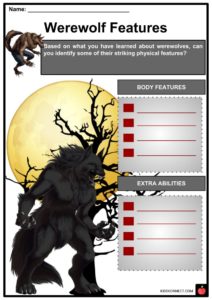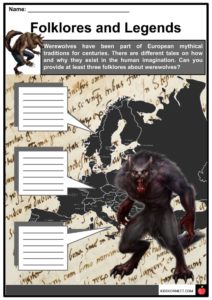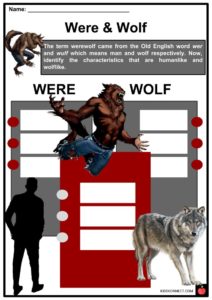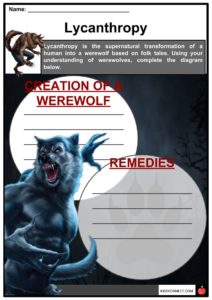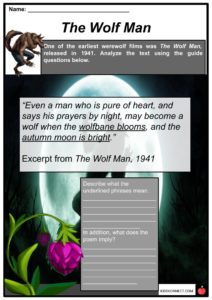Download This Sample
This sample is exclusively for KidsKonnect members!
To download this worksheet, click the button below to signup for free (it only takes a minute) and you'll be brought right back to this page to start the download!
Sign Me Up
Table of Contents
In mythology, a werewolf, also referred to as a Lycanthrope, is a mortal with the power to shapeshift into a wolf, either on purpose or as a consequence of a curse or disease, with the transition taking place on a full moon night—the roots of belief in this talent or condition, known as lycanthropy.
See the fact file below for more information on werewolf or alternatively, you can download our 19-page Werewolf worksheet pack to utilize within the classroom or home environment.
Key Facts & Information
History
Indo-European Comparative Mythology
- Although stories of people changing into wolves have their roots in previous pre-Christian beliefs, the European theme of the demonic Werewolf consuming human flesh dates back to a joint development throughout the Middle Ages in the framework of Christianity.
- Their underlying common ancestor may be traced back to Proto-Indo-European mythology, where lycanthropy is rebuilt as a part of the initiation of the kóryos trooper class, which may have featured a religion focused on dogs and wolves connected with a young, unmarried warrior age grade. McCone is the standard comparative survey of this part of Indo-European mythology.
Classical Antiquity
- Ancient Greek literature and myth have a few references to men transforming into wolves. In his Histories, Herodotus stated that the Neuri, a tribe located northeast of Scythia, were all converted into wolves once a year for several days before returning to their human form. Pomponius Mela also described this state.
- In his poetry book Eclogues, Virgil wrote of a man named Moeris who transformed himself into a wolf by using plants and poisons gathered in his home Pontus. In Gaius Petronius Arbiter’s Satyricon, published in 60 BCE, one of the characters, Niceros, relates a story at a banquet about a buddy who changed into a wolf (chs. 61-61). “When I check for my buddy, I discover he’d undressed and pilled his clothing on the wayside,” he explained. He pees in a circle around his clothing and then transforms into a wolf. He began howling after transforming into a wolf and fled into the woods.
- Werewolves were referenced by early Christian authors as well. Augustine of Hippo presents a narrative comparable to Pliny the Elder’s in the City of God. It also addressed the bodily metamorphosis in the Capitulatum Episcopi, which was attributed to the Congress of Ancyra in the fourth century and became the Church’s primary doctrinal text.
- Werewolves are frequently referred to as versipellis (“turn skin”) in the writings of Roman authors. To describe the bodily metamorphosis of werewolves, Augustine instead employs the word “in lupum fuisse mutatum” (turned into the form of a wolf), which is comparable to expressions used in the medieval era.
Middle Ages
- There is evidence throughout medieval Europe of widespread belief in werewolves, and this evidence spans most of the mainland as well as the British Isles. Werewolves were referenced in Medieval legal codes, such as King Cnut’s Ecclesiastical Ordinances, which indicate that the regulations are intended to guarantee that “the wildly bold werewolf does not destroy, nor bite too many of the spiritual flock.”
- Another example is Marie De France’s poem Bisclavret (c.1200), in which the titular lord Bisclavret is forced to shift into a wolf every week for unspecified reasons. When his wicked wife stole the garments, he needed to regain his human shape, and he evaded the king’s wolf hunt by pleading with the monarch for compassion and subsequently joined the king. His demeanor in court was polite until his wife and her new husband came when his vicious attack on the pair was declared justified and disclosed the truth.
- Many motifs present in other werewolf tales, such as the removal of clothes and the desire to abstain from devouring human flesh, may be found in Pliny the Elder and the second of Gervase of Tilbury’s werewolf tales, about a werewolf named Chauvevaire.
- The German word werewolf was mentioned in the 11th century by Burchard von Worms and in the 13th century by Bertold of Regensburg. However, it appears in some medieval German poetry or literature.
- While Baring-Gould claims that references to werewolves are infrequent in England, presumably because whatever value the “wolf-men” of Germanic paganism held, the associated beliefs and practices were successfully suppressed after Christianization (or, if they continued, they did so outside of the circle of literacy available to us), we have references other than those mentioned above.
- May discovered such werewolves in the work of the 9th-century Welsh Monk Nennius; can find female werewolves in the 12th-century Irish book Tales of the Elders; and Welsh werewolves in the 12th to 13th-century work.
- The medieval scenario gave rise to the dual type of werewolf legend in early modern Europe. On the one hand, the “Germanic” Werewolf is related to the witchcraft panic, while the “Slavic” werewolf or vlkolak is associated with the notion of the revenant or “vampire.”
- The “eastern” werewolf-vampire may be found in Central and Eastern European folklore, including Hungary, Romania, and the Balkans. In contrast, the “western” werewolf-sorcerer can be found in France, German-speaking Europe, and the Baltic.
- Being a werewolf was a famous charge in witch trials throughout history, and it even appeared in the Valais witch trials in the first part of the 15th century, one of the oldest such trials in history. Similarly, child-eating werewolves were documented in the Vaud (Switzerland) as early as 1448. Martin Luther used the term beer wolf to describe a possible ruler worse than a tyrant who must oppose in 1539.
Early Modern History
- In 16th-century France, there were several werewolf attacks and subsequent court prosecutions. In several instances, there was ample proof against the accused of killing and cannibalism but no proof of wolf affiliation. People have been frightened by such monsters in past cases, such as Gilles Garnier in Dole (1573), who was executed as a werewolf.
- The late 16th to early 17th centuries saw a surge in interest in lycanthropy as part of the European witch hunts. Several werewolf treatises were composed in France between 1595 and 1615. Werewolves were first spotted in Anjou in 1598, and a juvenile werewolf was condemned to life in Bordeaux in 1603.
- However, a paper written by a Vaud preacher in 1653 claimed that lycanthropy was a delusion. Following this, the only other report from the Vaud is from 1670, and it is that of a youngster who said he and his mother could transform into wolves, which he did not take seriously.
- In the early 17th century, witchcraft was persecuted by James I of England, who considered “warwoofles” as victims of illusion produced by “a natural superabundance of melancholy.”
- By 1650, belief in lycanthropy had almost disappeared from French-speaking Europe, as indicated by Diderot’s Encyclopedia, which ascribed stories of lycanthropy to a “mental illness.”
Asian Cultures
- Turkic Central Asian witchdoctors would deliberately turn into the humanoid “Kurtadam” after conducting lengthy and grueling ceremonies, casting a new, respectful light on werewolf mythology (literally meaning Wolfman). Because the wolf was the Turkic peoples’ totemic ancestral animal, any shaman in such a guise would be revered.
Characteristics
- The metamorphosis may be temporary or permanent; the were-beast may be the man himself metamorphosed; it may be his soul, which goes off seeking anyone it may consume, leaving its body in a condition of trance; or it may be nothing more than the human being’s messenger, a genuine animal or familiar spirit, whose strong connection with its owner is demonstrated by the fact that any harm to it is thought, via a phenomenon known as reverberation, to inflict a similar injury to the human being.
- Werewolves were thought to have distinguishing physical characteristics in human form in European mythology. These featured brows meeting at the bridge of the nose, curled fingernails, low-set ears, and swinging stride. One way to detect a werewolf in human form was to slash the accused’s skin so fur could be visible. Werewolves can use bristles and tongues to identify a Russian superstition.
- According to certain Swedish legends, the Werewolf could be differentiated from a typical wolf by running on three legs and extending the fourth backward to resemble a tail. Werewolves that revert to human form are typically described as feeble, crippled, and suffering from agonizing nervous despair. The Werewolf’s propensity to consume newly buried corpses was a generally loathed quality in medieval Europe, and it is well documented, notably in the nineteenth-century Annales Medico-psychologiques.
Modern Reception
Werewolf Fiction
- Most modern fiction depicts werewolves as sensitive to silver weapons but very immune to other damage, and this trait emerges in 19th-century German folklore. Bram Stoker’s 1897 book Dracula and short tale “Dracula’s Guest,” both published in 1897, relied on ancient myths of werewolves and kindred mythical creatures and “intended to articulate the anxieties of an era,” as well as the “fears of late Victorian patriarchy.”
- In “Dracula’s Guest,” a troop of military horsemen who come to the protagonist’s rescue drive off Dracula, who is described as a giant wolf and states that the only way to kill it is with a “Sacred Bullet.” It is also referenced in Bram Stoker’s novel Dracula. In the book, Count Dracula asserted that stories of werewolves sprang from his Szekely ethnic ancestry. He is said to be able to shapeshift into a wolf’s own will throughout the night but not during the day until noon.
- Werewolf of London, released in 1935, was the first element film to portray an anthropomorphic werewolf. Because lead actor Henry Hull was hesitant to spend long hours getting made up by makeup artist Jack Pierce, the primary werewolf in this picture is a stylish London scientist who keeps some of his flair and human characteristics after his change.
- Because there was no literary source to draw on, Universal Studios relied on a Balkan myth about a plant connected with lycanthropy instead of vampires. There is no mention of silver or other werewolf legends, such as cannibalism.
- Werewolves are sometimes represented as impervious to regular weapon damage, sensitive only to silver items such as a silver-tipped cane, bullet, or sword. They first utilized this feature in the film The Wolf Man. This aversion to silver can be so extreme that the mere contact of the metal on a werewolf’s skin causes burns.
- In particular works of fiction, werewolves’ powers transcend to human forms, such as invulnerability to conventional harm because of their healing factor, superhuman speed and strength, and the capability to land on their feet after a steep fall.
- Aggression and animalistic inclinations may also be heightened and more challenging to manage (hunger, sexual arousal). In these circumstances, talents are usually lessened in human form. In some stories, medical men with antidotes can heal it.
- Werewolves are typically portrayed as “working-class” monsters with low socioeconomic status. However, they can represent a wide range of social classes and be once used to describe “aristocratic decadence” in nineteenth-century horror literature.
Nazi Germany
- In 1942-43, Nazi Germany utilized the fabled creature’s name, Werewolf, as the codename for one of Hitler’s offices. The Nazi “Operation Werewolf” in the latter days of the war aimed to build a commando squad that would operate behind enemy lines as the Allies moved into Germany.
- Two fictional portrayals of “Operation Werewolf” exist in the US television series True Blood and J. By presenting the 1945 diehard Nazi commandos as true werewolves, L. Benét-mixes the two meanings of “Werewolf.”
Werewolf Worksheets
This is a fantastic bundle which includes everything you need to know about werewolf across 19 in-depth pages. These are ready-to-use Werewolf worksheets that are perfect for teaching students about Werewolf, which is also referred to as a Lycanthrope, is a mortal with the power to shapeshift into a wolf, either on purpose or as a consequence of a curse or disease, with the transition taking place on a full moon night.
Complete List of Included Worksheets
- Werewolf Facts
- Werewolf Features
- Folklore and Legends
- Were & Wolf
- Lycanthropy
- Werewolf in Films
- The Wolf Man
- Spooky Species
- Real Life Werewolf?
- About Werewolves
- From the Underworld
Frequently Asked Questions
What is a werewolf?
In mythology, a werewolf, also referred to as a Lycanthrope, is a mortal with the power to shapeshift into a wolf, either on purpose or as a consequence of a curse or disease, with the transition taking place on a full moon night—the roots of belief in this talent or condition, known as lycanthropy.
What are the characteristics of a werewolf?
The metamorphosis may be temporary or permanent; the were-beast may be the man himself metamorphosed; it may be his soul, which goes off seeking anyone it may consume, leaving its body in a condition of trance; or it may be nothing more than the human being’s messenger, a genuine animal or familiar spirit, whose strong connection with its owner is demonstrated by the fact that any harm to it is thought, via a phenomenon known as reverberation, to inflict a similar injury to the human being.
What is the description of Roman authors about werewolves?
Werewolves are frequently referred to as versipellis (“turn skin”) in the writings of Roman authors. To describe the bodily metamorphosis of werewolves, Augustine instead employs the word “in lupum fuisse mutatum” (turned into the form of a wolf), which is comparable to expressions used in the medieval era.
Why does the belief about lycanthropy disappear in France during 1650?
By 1650, belief in lycanthropy had almost disappeared from French-speaking Europe, as indicated by Diderot’s Encyclopedia, which ascribed stories of lycanthropy to a “mental illness.”
What is the modern reception of werewolves?
Most modern fiction depicts werewolves as sensitive to silver weapons but very immune to other damage, and this trait emerges in 19th-century German folklore. Bram Stoker’s 1897 book Dracula and short tale “Dracula’s Guest,” both published in 1897, relied on ancient myths of werewolves and kindred mythical creatures and “intended to articulate the anxieties of an era,” as well as the “fears of late Victorian patriarchy.”
Link/cite this page
If you reference any of the content on this page on your own website, please use the code below to cite this page as the original source.
Link will appear as Werewolf Facts & Worksheets: https://kidskonnect.com - KidsKonnect, October 5, 2019
Use With Any Curriculum
These worksheets have been specifically designed for use with any international curriculum. You can use these worksheets as-is, or edit them using Google Slides to make them more specific to your own student ability levels and curriculum standards.

